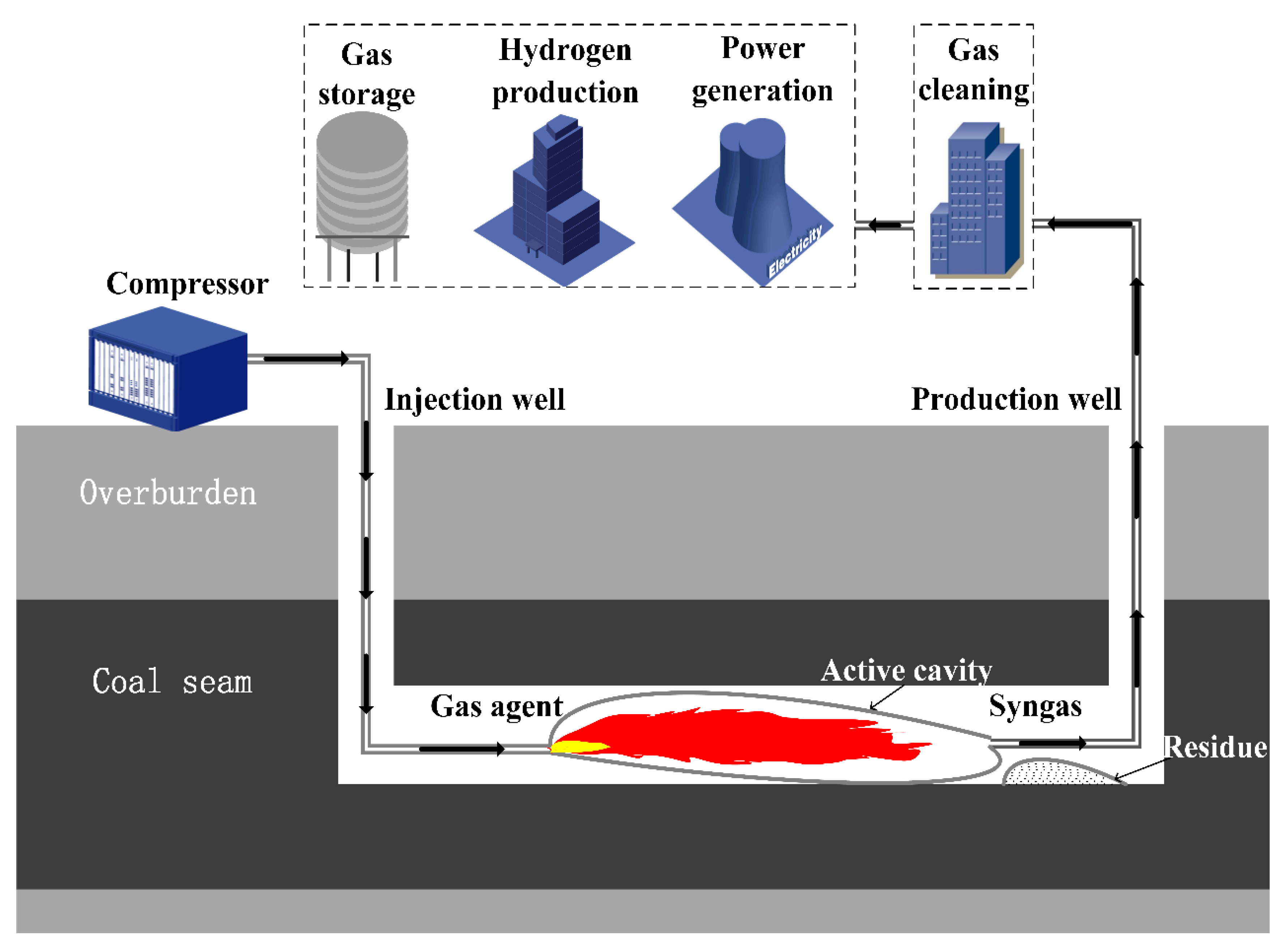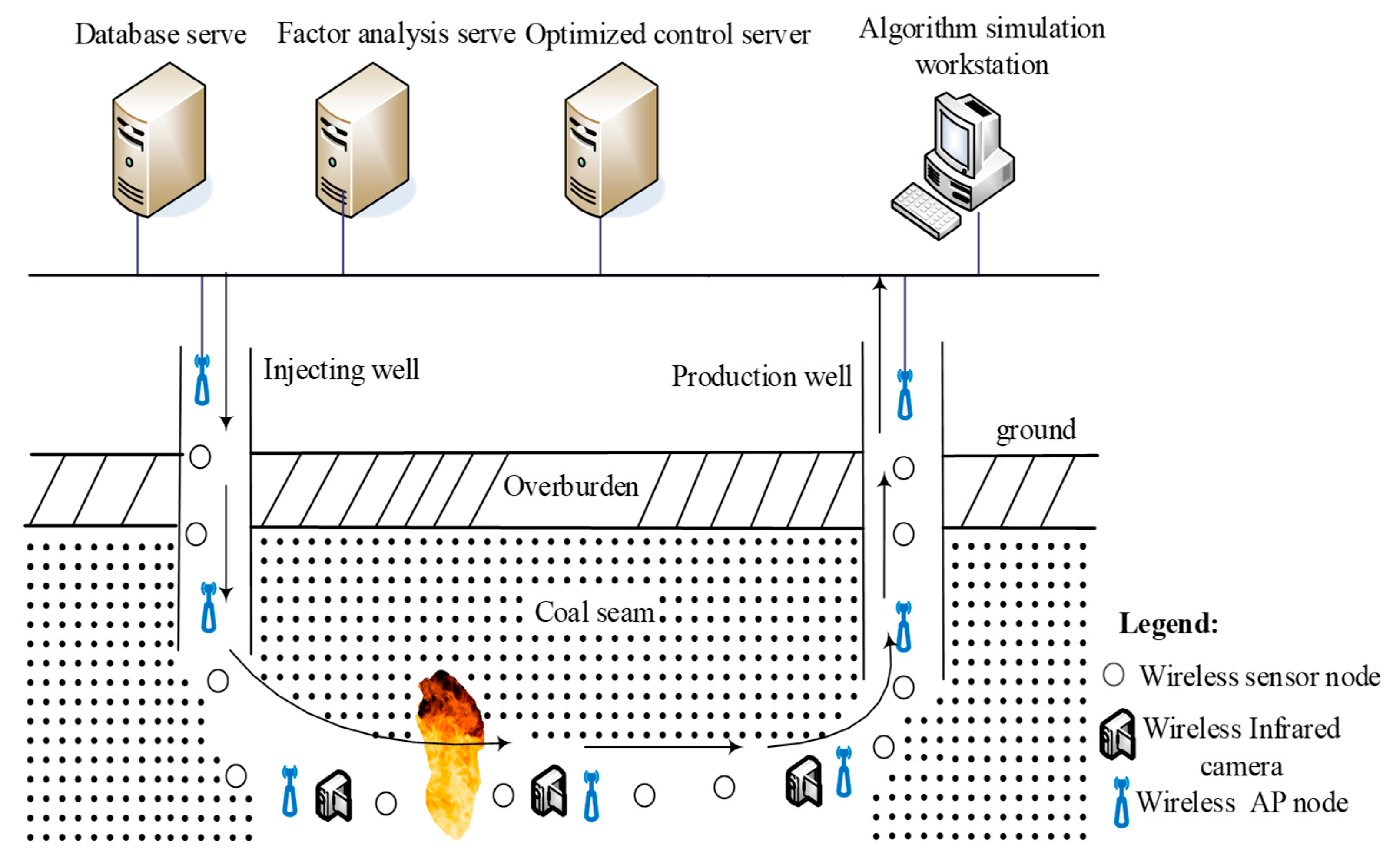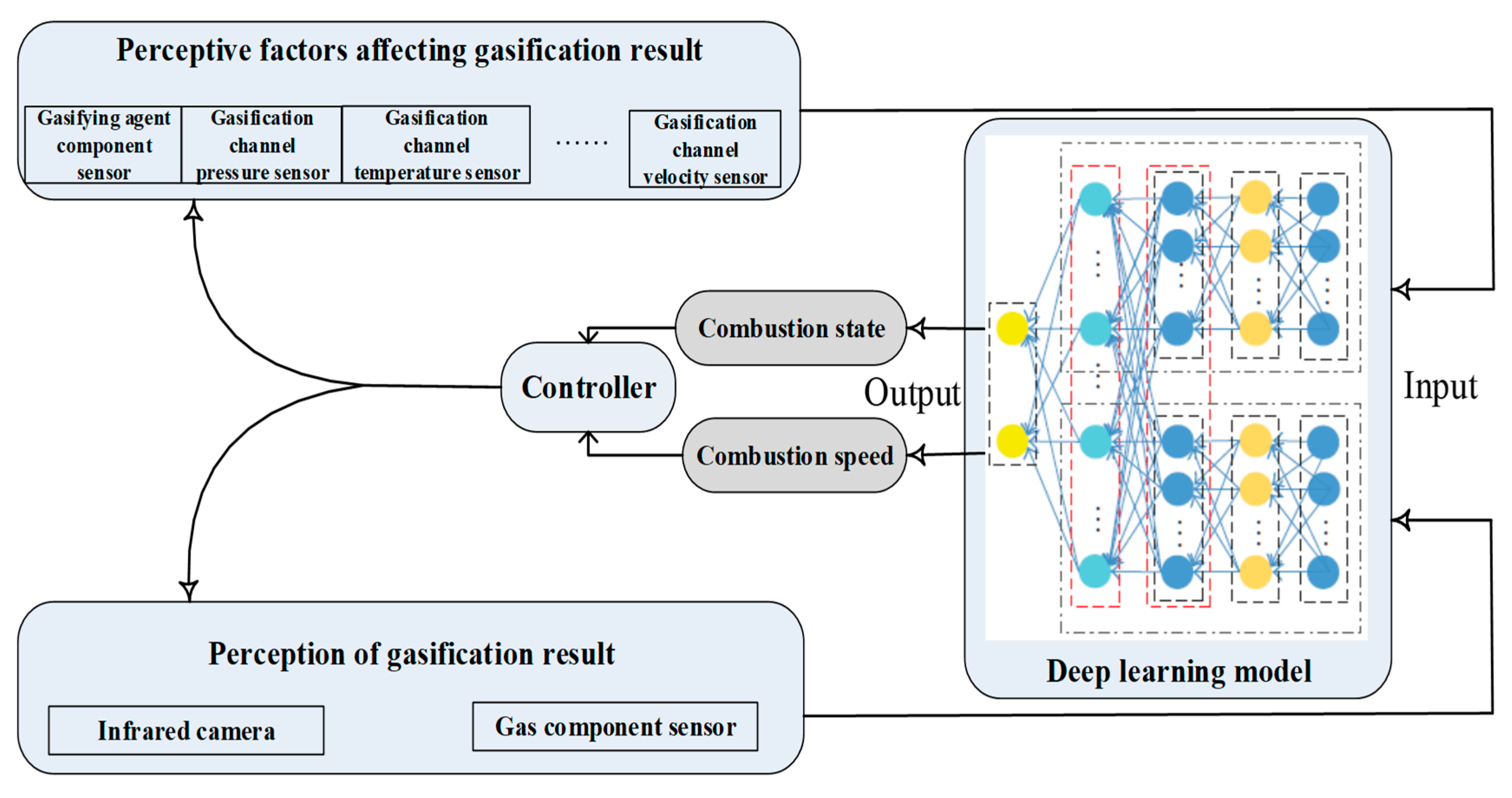Monitoring and Control in Underground Coal Gasification: Current Research Status and Future Perspective
Abstract
:1. Introduction
2. The Development of UCG Projects Worldwide
3. The Research Progress Related to Monitoring and Control for UCG
3.1. Research Status of UCG Monitoring
3.2. Research Status of UCG Control
4. Future Perspectives
4.1. Perception Platform of UCG Monitoring System Based on IoT
4.1.1. Package Structure Design for Moisture Proof and Thermal Insulation
4.1.2. Antenna Design
4.1.3. The Strategy for Energy Management Optimization
4.2. Optimal Control Model for UCG Based on Deep Learning
4.2.1. Feature Extraction and Classification Design for Network Model
4.2.2. Network Structure Design
4.2.3. Network Learning Augmentation
4.2.4. The Control for Network Model
5. Conclusions
Author Contributions
Funding
Conflicts of Interest
References
- Mcinnis, J.; Singh, S.; Huq, I. Mitigation and adaptation strategies for global change via the implementation of underground coal gasification. Mitig. Adapt. Strateg. Glob. Chang. 2016, 21, 479–486. [Google Scholar] [CrossRef]
- Bhutto, A.W.; Bazmi, A.A.; Zahedi, G. Underground coal gasification: From fundamentals to applications. Prog. Energy Combust. Sci. 2013, 39, 189–214. [Google Scholar] [CrossRef]
- Green, M. Recent developments and current position of underground coal gasification. Proc. Inst. Mech. Eng. Part A J. Power Energy 2018, 232, 39–46. [Google Scholar] [CrossRef]
- Shafirovich, E.; Varma, A. Underground Coal Gasification: A Brief Review of Current Status. Ind. Eng. Chem. Res. 2009, 48, 7865–7875. [Google Scholar] [CrossRef]
- Nurzynska, K.; Iwaszenko, S.; Choroba, T. Database Application in Visualization of Process Data. In Beyond Databases, Architectures and Structures—Proceedings of the 10th International Conference BDAS 2014; Springer: Cham, Switzerland, 2014; Volume 424, pp. 537–546. [Google Scholar]
- Doucet, D.; Perkins, G.; Ulbrich, A.; Toit, E. Du Production of power using underground coal gasification. Energy Sources 2016, 38, 3653–3660. [Google Scholar] [CrossRef]
- Kostúr, K.; Laciak, M.; Durdan, M. Some influences of Underground Coal Gasification on the environment. Sustainability 2018, 10, 1512. [Google Scholar] [CrossRef]
- Kotyrba, A.; Stańczyk, K. Application of a GPR Technique for Monitoring of Simulated Underground Coal Gasification in a Large Scale Model. Near Surf. Geophys. 2013, 11, 505–515. [Google Scholar] [CrossRef]
- Kotyrba, A.; Stańczyk, K. Sensing underground coal gasification by ground penetrating radar. Acta Geophys. 2017, 65, 1185–1196. [Google Scholar] [CrossRef] [Green Version]
- Khan, M.M.; Mmbaga, J.P.; Shirazi, A.S.; Trivedi, J.; Liu, Q.; Gupta, R. Modelling Underground Coal Gasification—A Review. Energies 2015, 8, 12603–12668. [Google Scholar] [CrossRef] [Green Version]
- Nourozieh, H.; Kariznovi, M.; Chen, Z.; Abedi, J. Simulation Study of Underground Coal Gasification in Alberta Reservoirs: Geological Structure and Process Modeling. Energy Fuels 2010, 24, 3540–3550. [Google Scholar] [CrossRef]
- Cui, Y.; Liang, J.; Wang, Z.; Zhang, X.; Fan, C.; Liang, D.; Wang, X. Forward and reverse combustion gasification of coal with production of high-quality syngas in a simulated pilot system for in situ gasification. Appl. Energy 2014, 131, 9–19. [Google Scholar] [CrossRef]
- Daggupati, S.; Mandapati, R.N.; Mahajani, S.M.; Ganesh, A.; Mathur, D.K.; Sharma, R.K.; Aghalayam, P. Laboratory studies on combustion cavity growth in lignite coal blocks in the context of underground coal gasification. Energy 2010, 35, 2374–2386. [Google Scholar] [CrossRef]
- Daggupati, S.; Mandapati, R.N.; Mahajani, S.M.; Ganesh, A.; Sapru, R.K.; Sharma, R.K.; Aghalayam, P. Laboratory studies on cavity growth and product gas composition in the context of underground coal gasification. Energy 2011, 36, 1776–1784. [Google Scholar] [CrossRef]
- Lecun, Y.; Bengio, Y.; Hinton, G. Deep learning. Nature 2015, 521, 436–444. [Google Scholar] [CrossRef] [PubMed]
- Levine, S.; Finn, C.; Darrell, T.; Abbeel, P. End-to-End Training of Deep Visuomotor Policies. J. Mach. Learn. Res. 2016, 17, 1–40. [Google Scholar]
- Karpathy, A.; Li, F.-F. Deep Visual-Semantic Alignments for Generating Image Descriptions. IEEE Trans. Pattern Anal. Mach. Intell. 2017, 39, 664–676. [Google Scholar] [CrossRef] [PubMed] [Green Version]
- Silver, D.; Huang, A.; Maddison, C.J.; Guez, A.; Sifre, L.; Van Den Driessche, G.; Schrittwieser, J.; Antonoglou, I.; Panneershelvam, V.; Lanctot, M.; et al. Mastering the game of Go with deep neural networks and tree search. Nature 2016, 529, 484–489. [Google Scholar] [CrossRef]
- Graves, A.; Wayne, G.; Reynolds, M.; Harley, T.; Danihelka, I.; Grabska-Barwińska, A.; Colmenarejo, S.G.; Grefenstette, E.; Ramalho, T.; Agapiou, J.; et al. Hybrid computing using a neural network with dynamic external memory. Nature 2016, 538, 471–476. [Google Scholar] [CrossRef]
- Yi, L.; Deng, X.; Wang, M.; Ding, D.; Yan, W. Localized Confident Information Coverage Hole Detection in Internet of Things for Radioactive Pollution Monitoring. IEEE Access 2017, 5, 18665–18674. [Google Scholar] [CrossRef]
- Saravanan, K.; Anusuya, E.; Kumar, R.; Le, H.S. Real—time water quality monitoring using Internet of Things in SCADA. Environ. Monit. Assess. 2018, 190, 556. [Google Scholar] [CrossRef]
- Marques, G.; Ferreira, C.R.; Pitarma, R. A System Based on the Internet of Things for Real-Time Particle Monitoring in Buildings. Int. J. Environ. Res. Public Health 2018, 15, 821. [Google Scholar] [CrossRef] [PubMed]
- Mnih, V.; Kavukcuoglu, K.; Silver, D.; Rusu, A.A.; Veness, J.; Bellemare, M.G.; Graves, A.; Riedmiller, M.; Fidjeland, A.K.; Ostrovski, G. Human-level control through deep reinforcement learning. Nature 2015, 518, 529–533. [Google Scholar] [CrossRef] [PubMed]
- Wang, Z.; Song, C.; Chen, T. Deep learning based monitoring of furnace combustion state and measurement of heat release rate. Energy 2017, 131, 106–112. [Google Scholar] [CrossRef]
- Zhang, G.; Wang, Z.; Zhao, L.; Qi, Y.; Wang, J. Coal-Rock Recognition in Top Coal Caving Using Bimodal Deep Learning and Hilbert-Huang Transform. Shock Vib. 2017, 2017, 3809525. [Google Scholar] [CrossRef]
- Vyas, D.U.; Singh, R.P. Worldwide Developments in UCG and Indian Initiative. Procedia Earth Planet. Sci. 2015, 11, 29–37. [Google Scholar] [CrossRef] [Green Version]
- Klimenko, A.Y. Early Ideas in Underground Coal Gasification and Their Evolution. Energies 2009, 2, 456–476. [Google Scholar] [CrossRef] [Green Version]
- Imran, M.; Kumar, D.; Kumar, N.; Qayyum, A.; Saeed, A.; Bhatti, M.S. Environmental concerns of underground coal gasification. Renew. Sustain. Energy Rev. 2014, 31, 600–610. [Google Scholar] [CrossRef]
- Khadse, A.; Qayyumi, M.; Mahajam, S.; Aghalayam, P. Underground coal gasification: A new clean coal utilization technique for India. Energy 2007, 32, 2061–2071. [Google Scholar] [CrossRef] [Green Version]
- Li, Y.; Liang, X.; Liang, J. An overview of the Chinese UCG program. Data Sci. J. 2007, 6, S460–S466. [Google Scholar] [CrossRef]
- Yang, D.; Koukouzas, N.; Green, M.; Sheng, Y. Recent development on underground coal gasification and subsequent CO2 storage. J. Energy Inst. 2016, 89, 469–484. [Google Scholar] [CrossRef]
- Singan, A.; Ranade, V.V. Deployment of underground coal gasification in India. Curr. Sci. 2017, 113, 218–227. [Google Scholar] [CrossRef]
- Khadse, A.N. Resources and economic analyses of underground coal gasification in India. Fuel 2015, 142, 121–128. [Google Scholar] [CrossRef]
- Olateju, B.; Kumar, A. Techno-economic assessment of hydrogen production from underground coal gasification (UCG) in Western Canada with carbon capture and sequestration (CCS) for upgrading bitumen from oil sands. Appl. Energy 2013, 111, 428–440. [Google Scholar] [CrossRef]
- Perkins, G.; du Toit, E.; Cochrane, G.; Bollaert, G. Overview of underground coal gasification operations at Chinchilla, Australia. Energy Sources Part A Recovery Util. Environ. Eff. 2016, 38, 3639–3646. [Google Scholar] [CrossRef]
- Mallett, C.W. Environmental controls for underground coal gasification. Proc. Inst. Mech. Eng. Part A J. Power Energy 2018, 232, 47–55. [Google Scholar] [CrossRef]
- Walker, L. UCG commercialization and the Cougar Energy project at Kingaroy, Queensland, Australia. Undergr. Coal Gasif. Combust. 2018, 503–526. [Google Scholar] [CrossRef]
- Kapusta, K.; Stanczyk, K. Development conditions and limitations of the underground coal gasification in Poland. Przem. Chem. 2009, 88, 331–338. [Google Scholar]
- Shackley, S.; Mander, S.; Reiche, A. Public perceptions of underground coal gasification in the United Kingdom. Energy Policy 2006, 34, 3423–3433. [Google Scholar] [CrossRef]
- Sheng, Y.; Benderev, A.; Bukolska, D.; Eshiet, K.I.-I.; da Gama, C.D.; Gorka, T.; Green, M.; Hristov, N.; Katsimpardi, I.; Kempka, T.; et al. Interdisciplinary studies on the technical and economic feasibility of deep underground coal gasification with CO2 storage in bulgaria. Mitig. Adapt. Strateg. Glob. Chang. 2016, 21, 595–627. [Google Scholar] [CrossRef]
- Zieleniewski, M.; Brent, A.C. Evaluating the costs and achievable benefits of extending technologies for uneconomical coal resources in South Africa: The case of underground coal gasification. J. Energy S. Afr. 2008, 19, 21–31. [Google Scholar]
- Sarhosis, V.; Lavis, S.; Mostade, M.; Thomas, H.R. Towards commercialising underground coal gasification in the EU. Environ. Geotech. 2017, 4, 113–122. [Google Scholar] [CrossRef]
- Su, F.; Hamanaka, A.; Itakura, K.; Zhang, W.; Deguchi, G.; Sato, K.; Takahashi, K.; Kodama, J. Monitoring and evaluation of simulated underground coal gasification in an ex-situ experimental artificial coal seam system. Appl. Energy 2018, 223, 82–92. [Google Scholar] [CrossRef]
- Kostúr, K.; Laciak, M.; Durdán, M.; Kačur, J.; Flegner, P. Low-calorific gasification of underground coal with a higher humidity. Measurement 2015, 63, 69–80. [Google Scholar] [CrossRef]
- Perkins, G. Underground coal gasification—Part I: Field demonstrations and process performance. Prog. Energy Combust. Sci. 2018, 67, 158–187. [Google Scholar] [CrossRef]
- Kačur, J.; Kostúr, K. Approaches to the gas control in UCG. Acta Polytech. 2017, 57, 182–200. [Google Scholar] [CrossRef]
- Perkins, G. Underground coal gasification—Part II: Fundamental phenomena and modeling. Prog. Energy Combust. Sci. 2018, 67, 234–274. [Google Scholar] [CrossRef]
- Mellors, R.; Yang, X.; White, J.A.; Ramirez, A.; Wagoner, J.; Camp, D.W. Advanced geophysical underground coal gasification monitoring. Mitig. Adapt. Strateg. Glob. Chang. 2016, 21, 487–500. [Google Scholar] [CrossRef]
- Wang, J.H.; Wang, H.J.; Wang, Z.T. Design of UCG Intelligent Monitoring System Based on Wireless Ad Hoc Network. Coal Mine Mach. 2017, 38, 9–11. (In Chinese) [Google Scholar] [CrossRef]
- Guan, L.I.; Wen, L.I.; Jia, W.E.I. Monitoring and control system of UCG process based on S7—300 PLC. J. North China Inst. Sci. Technol. 2016, 13, 86–91. (In Chinese) [Google Scholar]
- Barnwal, R.P.; Bharti, S.; Misra, S.; Obaidat, M.S. UCGNet: Wireless sensor network-based active aquifer contamination monitoring and control system for underground coal gasification. Int. J. Commun. Syst. 2017, 30, e2852. [Google Scholar] [CrossRef]
- Su, F.; Itakura, K.; Deguchi, G.; Ohga, K. Monitoring of coal fracturing in underground coal gasification by acoustic emission techniques. Appl. Energy 2017, 189, 142–156. [Google Scholar] [CrossRef]
- Yang, L.H.; Liu, S.Q. Temperature-control Blasting Underground Coal Gasification in the Inclined Coal Seams with a Short Wall. Energy Sources Part A Recovery Util. Environ. Eff. 2010, 32, 532–541. [Google Scholar] [CrossRef]
- Yang, L.H.; Pang, X.L.; Liu, S.Q.; Chen, F. Temperature and Gas Pressure Features in the Temperature-control Blasting Underground Coal Gasification. Energy Sources Part A Recovery Util. Environ. Eff. 2010, 32, 1737–1746. [Google Scholar] [CrossRef]
- Yang, L. Three-Dimensional Unstable Non-linear Numerical Analysis of the Underground Coal Gasification with Free Channel. Energy Sources Part A Recovery Util. Environ. Eff. 2006, 28, 1519–1531. [Google Scholar] [CrossRef]
- Yang, L. Study on the model experiment and numerical simulation for underground coal gasification. Fuel 2004, 83, 573–584. [Google Scholar] [CrossRef]
- Kačur, J.; Durdán, M.; Laciak, M.; Flegner, P. Impact analysis of the oxidant in the process of underground coal gasification. Measurement 2014, 51, 147–155. [Google Scholar] [CrossRef]
- Perkins, G.; Sahajwalla, V. A Numerical Study of the Effects of Operating Conditions and Coal Properties on Cavity Growth in Underground Coal Gasification. Energy Fuels 2006, 20, 596–608. [Google Scholar] [CrossRef]
- Uppal, A.A.; Bhatti, A.I.; Aamir, E.; Samar, R.; Khan, S.A. Control oriented modeling and optimization of one dimensional packed bed model of underground coal gasification. J. Process Control 2014, 24, 269–277. [Google Scholar] [CrossRef]
- Uppal, A.A.; Alsmadi, Y.M.; Utkin, V.I.; Bhatti, A.I.; Khan, S.A. Sliding Mode Control of Underground Coal Gasification Energy Conversion Process. IEEE Trans. Control Syst. Technol. 2018, 26, 587–598. [Google Scholar] [CrossRef]
- Yang, D.; Sarhosis, V.; Sheng, Y. Thermal–mechanical modelling around the cavities of underground coal gasification. J. Energy Inst. 2014, 87, 321–329. [Google Scholar] [CrossRef] [Green Version]
- Prabu, V.; Jayanti, S. Simulation of cavity formation in underground coal gasification using bore hole combustion experiments. Energy 2011, 36, 5854–5864. [Google Scholar] [CrossRef]



| Test Site | Country | Year | Seam Thickness (m) | Seam Depth (m) | Coal Gasified (ton) | Syngas cv (mj/m3) |
|---|---|---|---|---|---|---|
| Lisichansk | Russia | 1934–1936 | 0.75 | 24 | 3–4 | |
| Lisichansk | Ukraine | 1943–1963 | 0.4 | 400 | 3.2 | |
| Gorlovka | Russia | 1935–1941 | 1.9 | 40 | 6–10 | |
| Podmoskova | Russia | 1940–1962 | 2 | 40 | 6 with O2 | |
| Bois-la-Dame | Belgium | 1948 | 1 | |||
| Newman Spinney | UK | 1949–1959 | 1 | 75 | 180 | 2.6 |
| Yuzhno-Abinsk | Russia | 1955–1989 | 2-Sep | 138 | 2 × 106 | 9–12.1 |
| Angren | Uzbekistan | 1965–now | 4 | 110 | >1 × 107 | 3.6 |
| Hanna 1 | USA | 1973–1974 | 9.1 | 120 | 3130 | |
| Hanna 2 | USA | 1975–1976 | 9.1 | 84 | 7580 | 5.3 |
| Hoe Creek 1 | USA | 1976 | 7.5 | 100 | 112 | 3.6 |
| Hanna 3 | USA | 1977 | 9.1 | 84 | 2370 | 4.1 |
| Hoe Creek 2A | USA | 1977 | 7.5 | 100 | 1820 | 3.4 |
| Hoe Creek 2B | USA | 1977 | 7.5 | 100 | 60 | 9 |
| Hanna 4 | USA | 1977–1979 | 9.1 | 100 | 4700 | 4.1 |
| Hoe Creek 3A | USA | 1979 | 7.5 | 100 | 290 | 3.9 |
| Hoe Creek 3B | USA | 1979 | 7.5 | 100 | 3190 | 6.9 |
| Pricetown | USA | 1979 | 1.8 | 270 | 350 | 6.1 |
| Rawlins 1A | USA | 1979 | 18 | 105 | 1330 | 5.6 |
| Rawlins 1B | USA | 1979 | 18 | 105 | 169 | 8.1 |
| Rawlins 2 | USA | 1979 | 18 | 130–180 | 7760 | 11.8 |
| Brauy-en-Artois | France | 1981 | 1200 | |||
| Thulin | Belgium | 1982–1984 | 860 | |||
| Centralia Tono A | USA | 1984–1985 | 6 | 75 | 190 | 9.7 |
| Centralia Tono B | USA | 1984–1985 | 6 | 75 | 390 | 8.4 |
| Haute-Duete | France | 1985–1986 | 2 | 880 | ||
| Thulin | Belgium | 1986–1987 | 6 | 860 | 157 | |
| Rocky Mountain 1A | USA | 1987–1988 | 7 | 110 | 11,200 | 9.5 |
| Rocky Mountain 1B | USA | 1987–1988 | 7 | 110 | 4440 | 8.8 |
| EI Tremedal | Spain | 1997 | 2 | 600 |
| Countries | Year of Project Commencement | Company Organization | Objective |
|---|---|---|---|
| China | 2011 | UCG Research Centers (Beijing) Seamwell, China Energy Conservation and Environmental Protection Corporation Zhengzhou Coal Industry Co., Ltd. | Power Generation H2 for fuel cells. |
| India | 2005 | Neyvell Lignite Corporation Limited Central Mine Planning and Design Institute Limited Central Coalfields Ltd., Western Coalfields Ltd. | Power Generation Study and evaluate the calorific value of the gas generated. |
| Pakistan | 2009 | Thar Coal & Energy Board | Power Generation. |
| the U.S. | 2005 | Lawrence Livermore National Laboratories Linc Energy, Carbon Energy and Ergo Energy | Natural gas liquefaction, Developing 3D cavity growth simulators. |
| Australia | 2007 | Linc Energy company | UCG-CCS, UCG-IGCC Power Generation. |
| Poland | 2007 | Central Mining Institute of Poland | environmental and safety issues related to UCG processes. |
© 2019 by the authors. Licensee MDPI, Basel, Switzerland. This article is an open access article distributed under the terms and conditions of the Creative Commons Attribution (CC BY) license (http://creativecommons.org/licenses/by/4.0/).
Share and Cite
Xiao, Y.; Yin, J.; Hu, Y.; Wang, J.; Yin, H.; Qi, H. Monitoring and Control in Underground Coal Gasification: Current Research Status and Future Perspective. Sustainability 2019, 11, 217. https://doi.org/10.3390/su11010217
Xiao Y, Yin J, Hu Y, Wang J, Yin H, Qi H. Monitoring and Control in Underground Coal Gasification: Current Research Status and Future Perspective. Sustainability. 2019; 11(1):217. https://doi.org/10.3390/su11010217
Chicago/Turabian StyleXiao, Yuteng, Jihang Yin, Yifan Hu, Junzhe Wang, Hongsheng Yin, and Honggang Qi. 2019. "Monitoring and Control in Underground Coal Gasification: Current Research Status and Future Perspective" Sustainability 11, no. 1: 217. https://doi.org/10.3390/su11010217
APA StyleXiao, Y., Yin, J., Hu, Y., Wang, J., Yin, H., & Qi, H. (2019). Monitoring and Control in Underground Coal Gasification: Current Research Status and Future Perspective. Sustainability, 11(1), 217. https://doi.org/10.3390/su11010217





